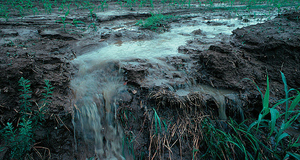From Earth Common Journal VOL. 4 NO. 1The Right and the Good: Communicating Environmental IssuesApplying Right and Good CommunicationsDr. Gordon Gow, Associate Professor and Director of Communications and Technology in the University of Alberta, writes: “Communication is at the heart of what we do in our personal and professional lives. To study ...[it]... is to come to better understanding of the social practices, institutions, and policies that shape our world” (Crookes et al. (ed), 2014, p.3). Because communications help us understand the world, the difference between Right and Good messages are especially relevant when practicing environmental communications. According to Meacham (2011), concepts of the Right and the Good “apply to what one should do, and often the debate is really about persuading someone to act in a certain way” (Meachan, 2011, para. 22). What happens in a situation where harm is clearly done and may continue to happen? Many environmental situations, including those in this article, such as China’s unchecked air pollution or north east Alberta’s growing tailings ponds of highly toxic waste products can be described as such. Recent degradation in air and water quality suggests that there is something to worry about. Preventing the ruin of humankind’s ecosystems is something that involves everyone, including our children. Humankind’s environmental decision-making history and advantages and disadvantages of Right and Good decisions are provided in the following quick overview of environmental development. Historical PerspectiveHumans first existed harmoniously with nature. Small, dispersed groups hunted and gathered and caused little damage to the environment. Wastes or pollutants were natural, widely spread, and easily absorbed (McEwen, 1984, pp. 15-23). As human numbers increased, some became agricultural. Food surpluses were stored or traded for protection or goods. People interacted and societies expanded; cultures organized. Populations grew with prosperity. Eventually numbers of people overcame resources. Paul and Anne Ehrlich, authors of The Population Explosion, use the term ‘overpopulation’ to describe this situation (1990, pp. 37-40). Overpopulation and the illness and suffering it caused in England before the Industrial Revolution spurred Thomas Malthus to write An Essay on the Principle of Population (1826). Because of his ideas Malthus is now considered the father of an environmental movement that is known as limits to growth. In his 1826 essay, Malthus stresses that the Right thing to do is to maintain a population equal to its food production. Doing what is Good, such as constantly satisfying sexual urges, will overpopulate. “Population,” Malthus writes, “must always be kept ... to the level of the means of subsistence” (1826, p. 4, Preface). After Malthus penned his principals and pointed to population problems, the industrial revolution in the mid 1800’s solved stresses by making more and varied resources available. Resources and consumption increased. Society called for and utilised new technologies, the economy improved, people got jobs, and money was made. “In 1846, Abraham Gesner began developing kerosene, a cleaner-burning alternative. By the end of the century, whale oil cost less than it did in 1831” (Lahart, Barta, & Batson, 2008, para. 13). The majority could afford to eat. However, more intense use of the earth’s resources modified earth systems, changed the way people live, and detracted from quality of life because moral and societal rules, as well as environmental conditions suffered (Lahart, Barta, & Batson, 2008). Deteriorating air and water, as well as improving food production techniques and more use of automated machines led society to renewed thoughts of unlimited natural resources. Those who believed in these limits became known as Malthusians. Wide spread starvation decreased, and visions of a prosperous and powerful future increased. The threat of limits diminished. Malthusians’ theories were ridiculed. Lahart, Barta, and Batson (2008) quote Joseph Stiglitz to show attitudes towards Malthusian theories. “There is not a persuasive case to be made,” they write, “that we face a problem from the exhaustion of our resources in the short or medium run” (2008, para. 15). Malthusian, or what became Neo-Malthusian, ideas took on renewed interest in the early 1970s after the 1972 book “The Limits to Growth” by Donella Meadows was published. The book’s subject matter was discussed at the 1972 first Club of Rome – according to its web site is an informal association of international, independent leading personalities from politics, business, and science, contributing systemic, interdisciplinary, holistic ways to a better world (Club of Rome). In 1972 the Club of Rome predicted that if rapid growth continued, there would be a sudden and uncontrollable decline in population and industrial capacity. However, technological advances and reversing trends (society doing the Right thing), which arguably came about because of the Club of Rome predictions, affected outcomes. Despite the five key areas: population, agricultural production, natural resources, industrial production, and pollution not collapsing, one mathematical calculation made remained indisputable (Randers et al., 2013). “Continued exponential growth is not sustainable indefinitely” (Randers et al., 2013). According to the experts at the 2013 Limits to Growth conference, the world has gone beyond the point where the environment can maintain its present form: the point of Inflection. The mathematical projection introduced at the conference indicates that society’s unchecked growth is breeching thresholds. Today, pollution has reached unprecedented levels; levels that are quickly approaching upper limits in which natural cycles, individual environments, and humans can adjust. Even though changes point to these limits, there are those who see things differently. Gains and LossesNew energy sources, virtual intelligence, and advances in science, medicine, agriculture, and society hold much promise. Increasing knowledge allows people to live longer and produce more goods in less time. We truly live as “Cornucopians,” a term used by Alex C. Michalos (1981). He suggests that as one resource depletes, civilization move on to another. However, these extended powers, increased knowledge, and other advances seem to disconnect people from values. Cornucopian interpretation of environmental history is either Good or Not Good depending upon perspective. On one hand, history shows progress. On the other hand, advances are over shadowed by environmental degradation, health concerns, and cultural or financial imbalances. On the Good side, governments are described as dynamic when setting goals, identifying problems, and putting resources towards meeting short-term goals and solutions. However, this ignores the interconnectivity of global systems. The two sides, the Right and the Good, continue to be at odds (Muir, Oct. 4, 2011; Cornucopian versus New Malthusian perspectives). Cornucopian’ resources are unlimited, deplete one and another is found. However, Garrett Harding, author of Tragedy of the Commons (1978), refers to Good decision making as “rushing to ruin” in a limited world. Using this “good” model, according to Harding (1978), humans moved from one self-destructive episode to another. According to Dragos (2009), in an article titled Julian Simon and the “Limits to Growth” Neo-Malthusianism, in the Electronic Journal of Sustainable Resources, Julian Simon joined the debate in the second half of the twentieth century. Malthusian or neo-Malthusians believed in clear-cut, limiting condition on growth. Simon suggested that people are resource creators, not destroyers. Dragos (2009) goes on to write that Simon believed that imagination would find solutions to challenges. Are we the masters of our destiny? Roger Pielke Jr. (2014) professor of environmental studies and Director of the Center for Science and Technology Policy Research, University of Colorado at Boulder, and John de Graaf (2014), co-author of bestseller Affluenza, and What’s the Economy For Anyway? debate whether no economic growth is Right. The article titled, “Can we have prosperity without growth?” in Chinadialog (Pielke Jr. & de Graaf, March 27, 2014) presents convincing arguments. Pielke Jr. (2014) divides anti-growth advocates into three types: “Neo-Malthusian” (want limits on population), “Peak Earther” (preach efficiency gains and substitution, as a solution to resource constraints), or “Luddite” (search for a way to stop the effects of technology on the economy). Sustainable growth, Pielke Jr. writes, is clearly not anti-growth. He provides statistics explaining that most growth occurs today in poor countries. He writes that arguments against growth are statements of anti-growth with respect to poor countries. Few if any people are actually saying that, he adds. Defining the three groups, Pielke Jr. writes, helps focus debates empirically or theoretically (Pielke Jr. & de Graaf, March 27, 2014). John de Graaf’s (2014) discussions echo that of Randers et al., made at the 2013 Limits to Growth Conference, “We can’t grow on like this,” de Graaf (2014) writes. By using geologic and historic events, de Graaf (2014) shows how little time humans have taken to reduce fisheries, fossil fuels, and soils by half while causing the extinction of countless species and bringing us dangerously close to changing the climate. de Graaf (2014) points to “Jevons Paradox,” which states more efficient energy use just makes us want to use more; de Graaf (2014) also refers to economist Stefano Bartolini who suggests that rapid economic growth is more a symptom of social decay than dynamism. Increasing growth leads to longer working hours and loss of natural habitat. Humans alleviate loss of nature by taking flights to gorgeous tropical beaches thereby depleting resources and speeding climate change. The argument being made by de Graaf (2014) also states that wealth is in the hands of few. Because of this, de Graaf (2014) writes, continued growth only serves to make the rich and poor more so. Marx, Keynes and other economists are also discussed to make his point. Share jobs, work less, and enjoy life. The piece ends with de Graaf (2014) quoting from a speech by Lyndon Johnson, “A Great Society would judge itself not by the quantity of its goods, but the quality of its goals” (Pielke R. Jr. & de Graaf J., March 27, 2014; Johnson, May22, 1964, para. 7). Arguments expressed by de Graaf (2014) manifest themselves in such movements as The Degrowth paradigm. Richard Swift, author and essayist, examined this paradigm on an episode of Ideas on CBC Radio hosted by P. Kennedy, December 10, 2013. On the program, advocates of Degrowth argue that a finite planet cannot continue to grow infinitely. Program participants suggest a paradigm shift from one of constant growth to a goal of an equitable and sustainable life. However, according to Swift on the CBC program Ideas in the Afternoon, the growing movement preaches and practices a more modest and sane alternative to constant expansion. The difficulty though, Swift explains is that it is difficult to maintain a sharable lifestyle in the real world of specialists, (Kennedy P. – Host, Monday March 24, 2014: 2 PM; The Degrowth Paradigm, Ideas in the Afternoon, CBC Radio One). Sayre (1981) suggests that a society is guided by self-interest. Producers supply consumers with affordable goods, therefore cheap labour and dependable energy supply are necessities. This self-interested relationship is self-destructive in a number of ways. The consumption of goods and the use of energy such as tailing ponds in Oil Sands production or Air pollution from burning fossil fuels create waste or pollutants. The storage of wastes and pollutants and the mining, transportation, and refinement of energy products interfere with or change ecological balances and increase the possibility of human conflicts. Struggles resulting from resource shortages are well documented. In 2008, Lahart, Barta, and Batson discussed the renewal of the Malthusian limits in an article in the Wall Street Journal (March 24). Waning reserves limit growth, while the acquisition of resources to fill the void poses other threats. The article describes major world powers vying for access to energy rich but politically unstable countries to ensure future energy and mineral supplies. Lahart et al. (2008), refer to long standing conflicts internationally and intensified conflicts between southern American states over water. Albertans don’t have to go that far to see evidence of water conflicts. Kerry Brewin, Senior Biologist with Dillon Consulting Limited, writes about the many that have taken place in Alberta. In the CBC Radio Feature, Blueprint H2O, Alberta, An Expert’s Opinion, Brewin uses the saying, "Whiskey's for drinking, and water’s for fighting over," (para. 1, 2014) to show its importance. The many conflicts concerning water usage are discussed in the piece, some of which happened because the existing regulations guiding the use of water were written when we thought the resource was infinite. When conservation groups were fighting battles with reasoned arguments to do what is Right, and protect Alberta’s watersheds with water management plans, their numbers were small and resources (money and volunteers) constrained. Traditional water consumers were well established and able to speak the language of politicians (Berwin, 2014, para. 4). Evidence was apparent that things needed to change, he writes, so in 1999 the new legislation included restraints on use and encouraged recycling efforts (Berwin, 2014, para. 5). Water is something that affects everyone. Without it, we die. Today, the armies fighting the battles in Alberta for sustainable water are large in numbers, and involve all sectors of government, environmental organizations, and grassroots stakeholders (interested or vested groups, organizations, or individuals). Now land users including First Nations peoples, and agriculture, industry, and recreation workers cooperate to promote Best Management Practices. Working together leads to Right decisions. Bringing everyone to the table involves other factors.Continued on Next Page » Suggested Reading from Inquiries Journal
Inquiries Journal provides undergraduate and graduate students around the world a platform for the wide dissemination of academic work over a range of core disciplines. Representing the work of students from hundreds of institutions around the globe, Inquiries Journal's large database of academic articles is completely free. Learn more | Blog | Submit Latest in Environmental Studies |

















